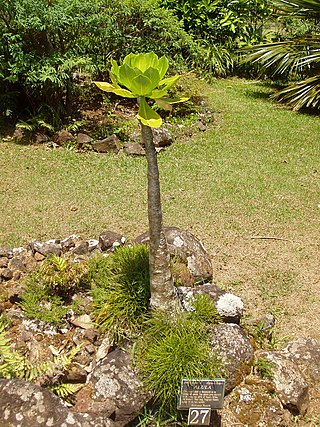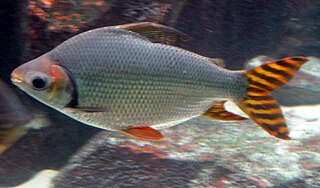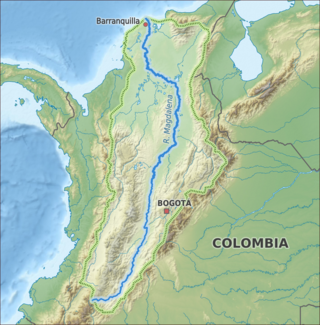
Obdurodon is a genus of extinct platypus-like Australian monotreme which lived from the Late Oligocene to the Late Miocene. Three species have been described in the genus, the type species Obdurodon insignis, plus Obdurodon dicksoni and Obdurodon tharalkooschild. The species appeared much like their modern day relative the platypus, except adults retained their molar teeth, and unlike the platypus, which forages on the lakebed, they may have foraged in the water column or surface.
The eelpouts are the ray-finned fish family Zoarcidae. As the common name suggests, they are somewhat eel-like in appearance. All of the 300 species are marine and mostly bottom-dwelling, some at great depths. Eelpouts are predominantly found in the Northern Hemisphere. The arctic, north pacific and north Atlantic oceans have the highest concentration of species, however species are found around the globe.

Caturus is an extinct genus of predatory fishes in the family Caturidae in the order Amiiformes, related to modern bowfin. Fossils of this genus range from 200 to 109 mya. It has been suggested that the genus is non-monophyletic with respect to other caturid genera.
Middle Button Island National Park is an Indian national park located in the Andaman and Nicobar Islands. The park was created in 1979 and is situated about 200 km (124 mi) northeast of Port Blair, capital of the island group. The total area that the national park covers is about 64 km2 (25 sq mi). Along with the neighbouring islands of North Button and South Button, both also national parks, it forms part of the Rani Jhansi Marine National Park off the coast of South Andaman Island.
South Button Island National Park is a national park located in the Andaman and Nicobar Islands off the coast of India, the total area of this protected island is about 5 km2 (2 sq mi), which make it as the smallest national park in India. Along with the neighbouring islands of North Button and Middle Button, both also national parks, it forms part of the Rani Jhansi Marine National Park off the coast of South Andaman Island.

Hypsocormus is an extinct genus of pachycormid fish from the Middle to Late Jurassic of Europe. Fossils have been found in Germany, France and the UK.

Brighamia insignis, commonly known as ʻŌlulu or Alula in Hawaiian, or colloquially as the vulcan palm or cabbage on a stick, is a species of Hawaiian lobelioid in the bellflower family, Campanulaceae. It is native to the islands of Kauaʻi and Niʻihau, but has been extinct in the wild since at least 2019-2020. This short-lived perennial species is a member of a unique endemic Hawaiian genus with only one other species.

The white-bellied heron also known as the imperial heron or great white-bellied heron, is a large heron species living in the foothills of the eastern Himalayas in northeast India and Bhutan to northern Myanmar. It inhabits undisturbed rivers and wetlands. It has been listed as Critically Endangered on the IUCN Red List since 2007, because the global population is estimated at less than 300 mature individuals and threatened by habitat loss and human disturbance. It is mostly dark grey with a white throat and underparts.

Mesonauta, the flag cichlids, is a small genus of cichlids native to the Amazon, Orinoco, Essequibo, Paraná and Paraguay basins in South America. Mesonauta is included in the subfamily Cichlasomatinae. They occur in various freshwater habitats such as streams and lakes, especially in areas with little water movement and aquatic vegetation. They are generally found in small groups that stay near the water surface. To avoid predators, adults may jump out of the water and juveniles mimic leaves.
Breitensteinia is a genus of catfishes of the family Akysidae. It includes three species.
Brycon insignis, the Tiete tetra, is a species of fish in the family Characidae. It is endemic to the Paraíba do Sul River basin in southeast Brazil. B. insignis migrates upstream to spawn and has traditionally been important to fisheries, but it is now a threatened species.
The one-and-a-half-stripe hap is a species of cichlid endemic to Lake Malawi where it prefers rocky areas. It is an egg-eater, seeking out and consuming the eggs of other fishes. This species can reach a length of 20.3 centimetres (8.0 in) TL. It can also be found in the aquarium trade.

Theliderma intermedia, the Cumberland monkeyface pearly mussel or Cumberland monkeyface, is a species of freshwater mussel in the family Unionidae, the river mussels. This aquatic bivalve mollusk is native to Tennessee and Virginia in the United States. Historically widespread in the upper Tennessee River system, it populations have been reduced by habitat destruction and pollution. It now only occurs in two tributaries: the Duck and Powell Rivers. It is a federally listed endangered species.

The Sonora Sucker, Catostomus insignis, is a medium-sized catostomid fish with 16 other species in the genus scattered throughout North America. This species is remarkably similar in appearance to the Yaqui Sucker.
P. insignis may refer to:
The blotched chub is a species of fish in the family Cyprinidae, the minnow and carp family. This fish species in native to the Southeastern region of the United States.

The kissing prochilodus or flag-tailed prochilodus is a species of South American freshwater fish in the family Prochilodontidae. It is native to central and western parts of the Amazon basin. It is migratory, moving in large groups into whitewater rivers to spawn, afterwards returning to blackwater and clearwater rivers, as well as flooded forests. It is important in fisheries and sometimes seen in the aquarium trade, but require a relatively large tank. It can reach a maximum standard length of 27.5 cm (10.8 in) and weight of 560 g (1.23 lb). It resembles the other members of the genus Semaprochilodus, where most species are silvery with orange-red fins and a striped tail. Adult S. insignis lack the dark flank spots that can be seen in adult S. taeniurus, but both species have these spots as juveniles.
Chomatodus is a prehistoric cartilaginous fish genus.

Trachelyopterus insignis is a species of catfish from the freshwater driftwood catfish family, Auchenipteridae. It is commonly found in rivers of northern South America, where it is called the chivo, the rengue, or the doncella.
Anoplarchus is a genus of marine ray-finned fishes belonging to the family Stichaeidae, the pricklebacks and shannies. These fishes are found in the eastern Pacific Ocean.









